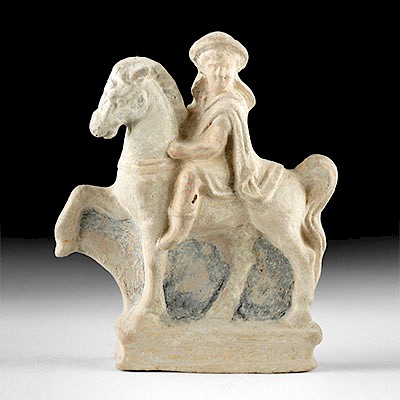Venezuelan Tairona Stone Batwing Pectoral
Lot 127e
About Seller
Artemis Gallery
686 S Taylor Ave, Ste 106
Louisville, CO 80027
United States
Selling antiquities, ancient and ethnographic art online since 1993, Artemis Gallery specializes in Classical Antiquities (Egyptian, Greek, Roman, Near Eastern), Asian, Pre-Columbian, African / Tribal / Oceanographic art. Our extensive inventory includes pottery, stone, metal, wood, glass and textil...Read more
Estimate:
$800 - $1,200
Absentee vs Live bid
Two ways to bid:
- Leave a max absentee bid and the platform will bid on your behalf up to your maximum bid during the live auction.
- Bid live during the auction and your bids will be submitted real-time to the auctioneer.
Bid Increments
| Price | Bid Increment |
|---|---|
| $0 | $25 |
| $300 | $50 |
| $1,000 | $100 |
| $2,000 | $250 |
| $5,000 | $500 |
| $10,000 | $1,000 |
| $20,000 | $2,500 |
| $50,000 | $5,000 |
| $100,000 | $10,000 |
| $200,000 | $20,000 |
About Auction
By Artemis Gallery
May 9, 2019
Set Reminder
2019-05-09 10:00:00
2019-05-09 10:00:00
America/New_York
Bidsquare
Bidsquare : Ancient | Asian | Ethnographic
https://www.bidsquare.com/auctions/artemis-gallery/ancient-asian-ethnographic-4110
Featuring classical antiquities, ancient and ethnographic art from cultures encompassing the globe. All legally acquired, legal to sell. Satisfaction guaranteed. Convenient in-house shipping. Artemis Gallery info@artemisgallery.com
Featuring classical antiquities, ancient and ethnographic art from cultures encompassing the globe. All legally acquired, legal to sell. Satisfaction guaranteed. Convenient in-house shipping. Artemis Gallery info@artemisgallery.com
- Lot Description
Pre-Columbian, found in Venezuela, traded from the Colombian Tairona culture, ca. 10th to 16th century CE. A fascinating example of a "batwing" pectoral, so called because of its resemblance to the flying mammal, although the actual meaning of its form is unknown. The stone is a beautiful banded black and white hardstone with faint brown inclusions. The "wings" widen at their terminals, and the trapezoidal "head" is at the upper center with sharply-angled corners. Items of this general shape have been found from southern Mexico to Venezuela as well as on some islands in the Caribbean, often found in caches of other stone artifacts buried under floors of houses and temples. Lucite display stand for photography purposes only. Size: 8" L x 1.8" W (20.3 cm x 4.6 cm).
The Kogi and Ica people, who are direct descendants of the Tairona, wear similar items as rattles, attached to the elbows of dancers. They may have been used similarly in the pre-Columbian era. However, this stone example - like many - lacks any drilled holes for attachment, and so archaeologists have suggested that the stone items were symbolic representations of wooden ornaments, created to be funerary offerings, similar to the ritually cached stone celts also common in this culture.
Provenance: private West Palm Beach, Florida, USA collection, acquired via inheritance from the collection of Louis L. Scher, found in Venezuela during the 1960s and 1970s
All items legal to buy/sell under U.S. Statute covering cultural patrimony Code 2600, CHAPTER 14, and are guaranteed to be as described or your money back.
A Certificate of Authenticity will accompany all winning bids.
We ship worldwide and handle all shipping in-house for your convenience.
#145091Minor nicks to peripheries, with light abrasions to both faces, otherwise intact and very good. Light earthen deposits throughout.Condition
- Shipping Info
-
All shipping is handled in-house for your convenience. Your invoice from Artemis Gallery will include shipping calculation instructions. If in doubt, please inquire BEFORE bidding for estimated shipping costs for individual items.
-
- Buyer's Premium



 EUR
EUR CAD
CAD AUD
AUD GBP
GBP MXN
MXN HKD
HKD CNY
CNY MYR
MYR SEK
SEK SGD
SGD CHF
CHF THB
THB













